Impact of AFTA on Malaysian Economy
VerifiedAdded on 2020/10/22
|11
|3050
|279
AI Summary
This report evaluates the impact of AFTA on Malaysia's primary, secondary, tertiary, and quaternary sectors. It examines the economic integration, production capacity, and Foreign Direct Investment (FDI) aspects that led to the formation of AFTA. The assignment also discusses the application of comparative advantage theory in intra-AFTA trades and its effectiveness in international trade. Overall, it provides insights into the positive and negative impacts of AFTA on Malaysia's economy.
Contribute Materials
Your contribution can guide someone’s learning journey. Share your
documents today.

INTERNATIONAL
BUSINESS
BUSINESS
Secure Best Marks with AI Grader
Need help grading? Try our AI Grader for instant feedback on your assignments.
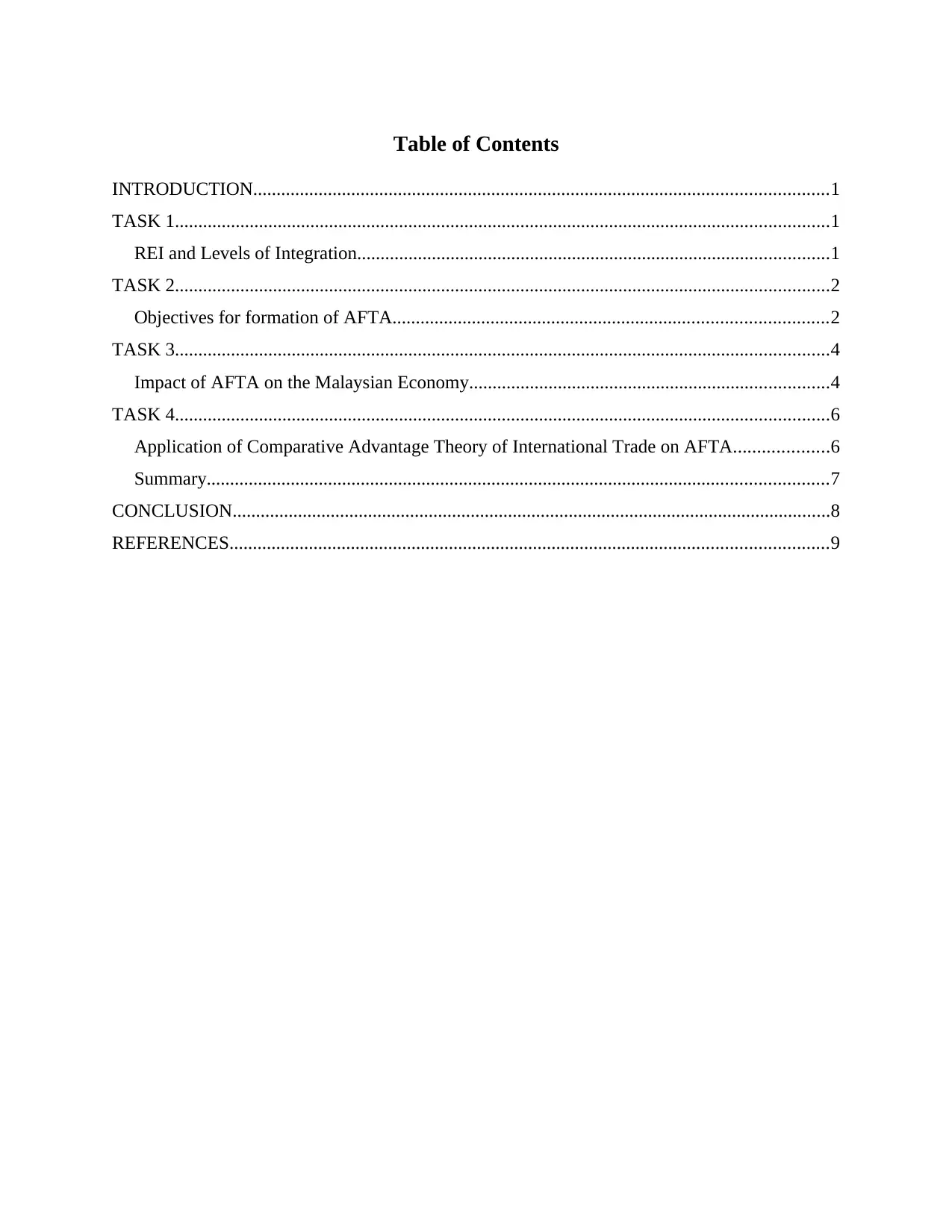
Table of Contents
INTRODUCTION...........................................................................................................................1
TASK 1............................................................................................................................................1
REI and Levels of Integration.....................................................................................................1
TASK 2............................................................................................................................................2
Objectives for formation of AFTA.............................................................................................2
TASK 3............................................................................................................................................4
Impact of AFTA on the Malaysian Economy.............................................................................4
TASK 4............................................................................................................................................6
Application of Comparative Advantage Theory of International Trade on AFTA....................6
Summary.....................................................................................................................................7
CONCLUSION................................................................................................................................8
REFERENCES................................................................................................................................9
INTRODUCTION...........................................................................................................................1
TASK 1............................................................................................................................................1
REI and Levels of Integration.....................................................................................................1
TASK 2............................................................................................................................................2
Objectives for formation of AFTA.............................................................................................2
TASK 3............................................................................................................................................4
Impact of AFTA on the Malaysian Economy.............................................................................4
TASK 4............................................................................................................................................6
Application of Comparative Advantage Theory of International Trade on AFTA....................6
Summary.....................................................................................................................................7
CONCLUSION................................................................................................................................8
REFERENCES................................................................................................................................9
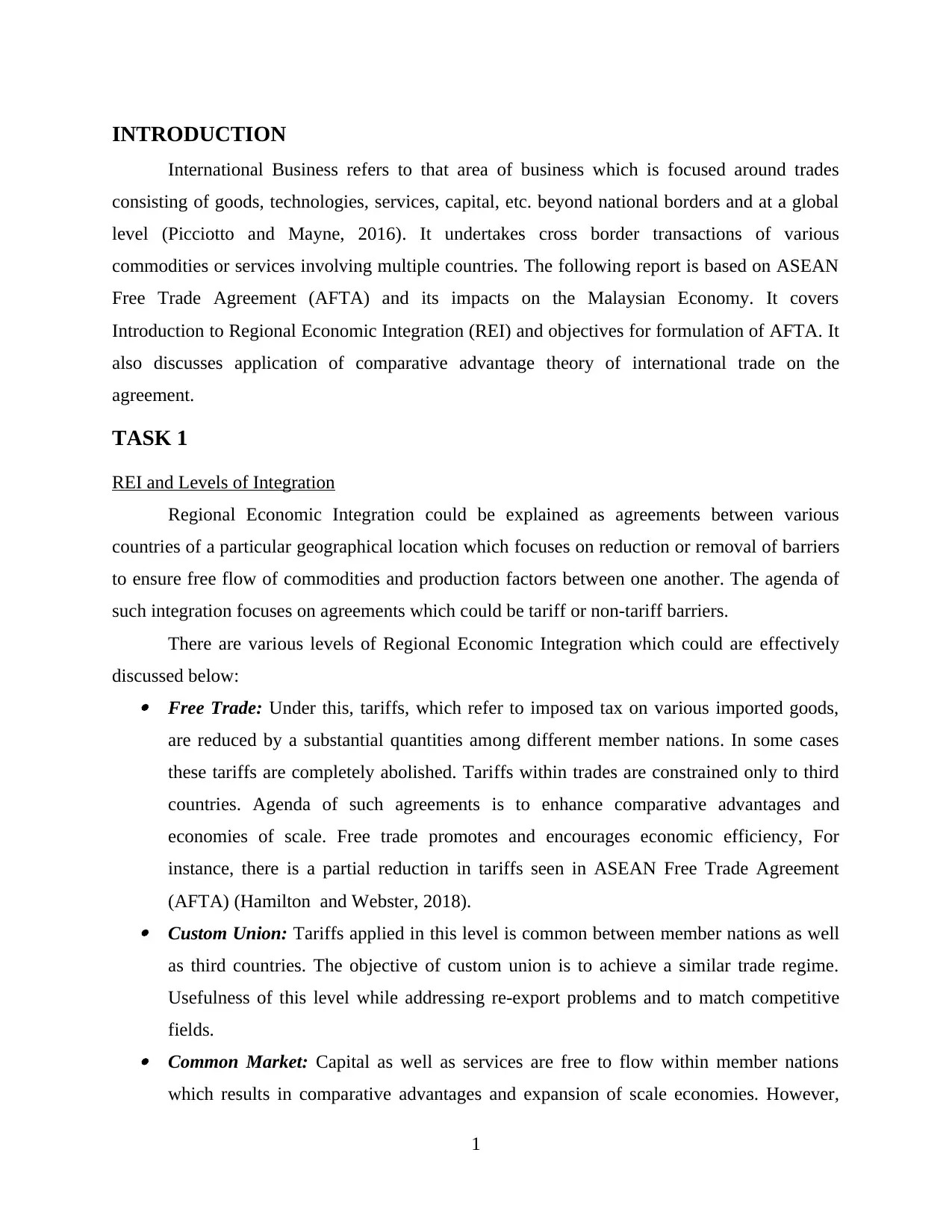
INTRODUCTION
International Business refers to that area of business which is focused around trades
consisting of goods, technologies, services, capital, etc. beyond national borders and at a global
level (Picciotto and Mayne, 2016). It undertakes cross border transactions of various
commodities or services involving multiple countries. The following report is based on ASEAN
Free Trade Agreement (AFTA) and its impacts on the Malaysian Economy. It covers
Introduction to Regional Economic Integration (REI) and objectives for formulation of AFTA. It
also discusses application of comparative advantage theory of international trade on the
agreement.
TASK 1
REI and Levels of Integration
Regional Economic Integration could be explained as agreements between various
countries of a particular geographical location which focuses on reduction or removal of barriers
to ensure free flow of commodities and production factors between one another. The agenda of
such integration focuses on agreements which could be tariff or non-tariff barriers.
There are various levels of Regional Economic Integration which could are effectively
discussed below: Free Trade: Under this, tariffs, which refer to imposed tax on various imported goods,
are reduced by a substantial quantities among different member nations. In some cases
these tariffs are completely abolished. Tariffs within trades are constrained only to third
countries. Agenda of such agreements is to enhance comparative advantages and
economies of scale. Free trade promotes and encourages economic efficiency, For
instance, there is a partial reduction in tariffs seen in ASEAN Free Trade Agreement
(AFTA) (Hamilton and Webster, 2018). Custom Union: Tariffs applied in this level is common between member nations as well
as third countries. The objective of custom union is to achieve a similar trade regime.
Usefulness of this level while addressing re-export problems and to match competitive
fields. Common Market: Capital as well as services are free to flow within member nations
which results in comparative advantages and expansion of scale economies. However,
1
International Business refers to that area of business which is focused around trades
consisting of goods, technologies, services, capital, etc. beyond national borders and at a global
level (Picciotto and Mayne, 2016). It undertakes cross border transactions of various
commodities or services involving multiple countries. The following report is based on ASEAN
Free Trade Agreement (AFTA) and its impacts on the Malaysian Economy. It covers
Introduction to Regional Economic Integration (REI) and objectives for formulation of AFTA. It
also discusses application of comparative advantage theory of international trade on the
agreement.
TASK 1
REI and Levels of Integration
Regional Economic Integration could be explained as agreements between various
countries of a particular geographical location which focuses on reduction or removal of barriers
to ensure free flow of commodities and production factors between one another. The agenda of
such integration focuses on agreements which could be tariff or non-tariff barriers.
There are various levels of Regional Economic Integration which could are effectively
discussed below: Free Trade: Under this, tariffs, which refer to imposed tax on various imported goods,
are reduced by a substantial quantities among different member nations. In some cases
these tariffs are completely abolished. Tariffs within trades are constrained only to third
countries. Agenda of such agreements is to enhance comparative advantages and
economies of scale. Free trade promotes and encourages economic efficiency, For
instance, there is a partial reduction in tariffs seen in ASEAN Free Trade Agreement
(AFTA) (Hamilton and Webster, 2018). Custom Union: Tariffs applied in this level is common between member nations as well
as third countries. The objective of custom union is to achieve a similar trade regime.
Usefulness of this level while addressing re-export problems and to match competitive
fields. Common Market: Capital as well as services are free to flow within member nations
which results in comparative advantages and expansion of scale economies. However,
1
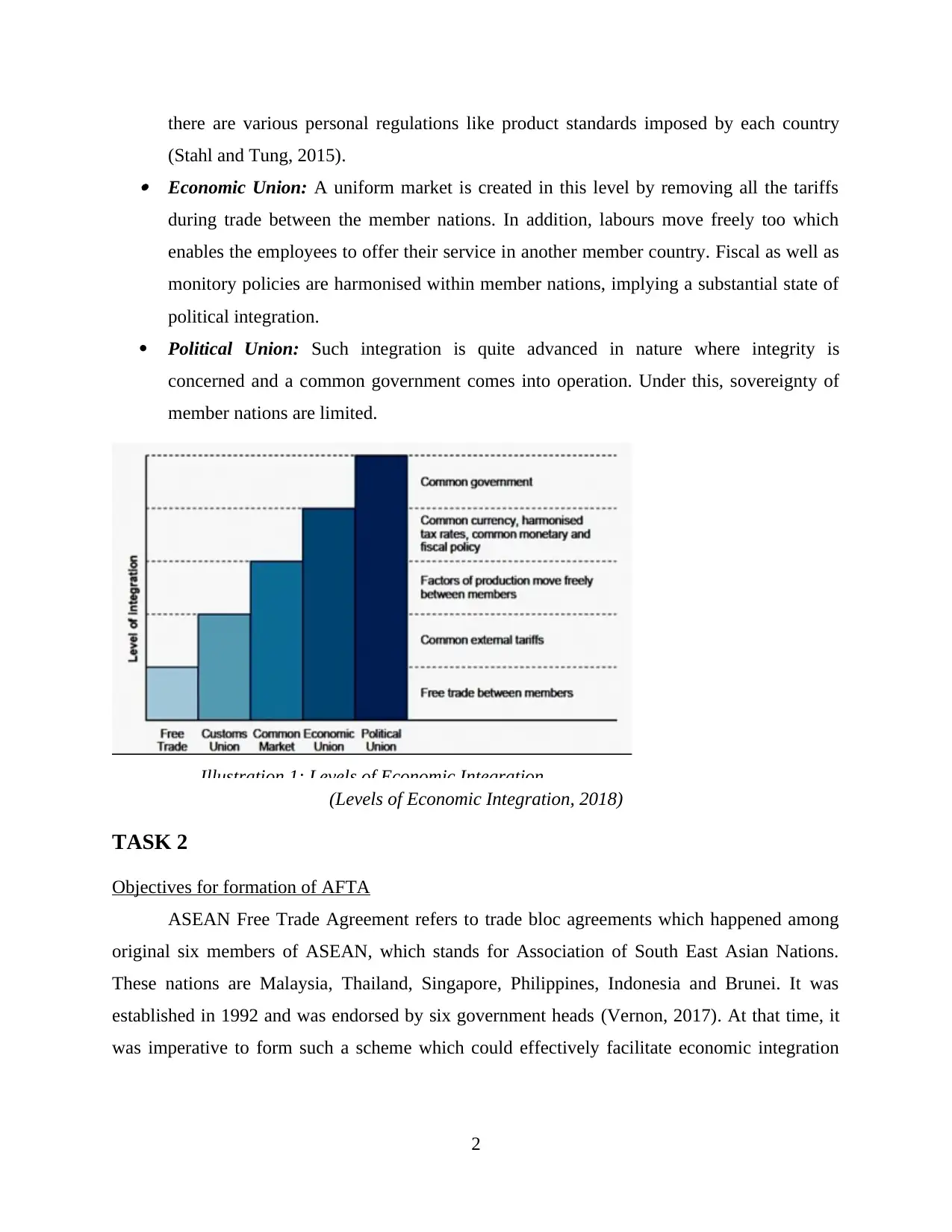
there are various personal regulations like product standards imposed by each country
(Stahl and Tung, 2015). Economic Union: A uniform market is created in this level by removing all the tariffs
during trade between the member nations. In addition, labours move freely too which
enables the employees to offer their service in another member country. Fiscal as well as
monitory policies are harmonised within member nations, implying a substantial state of
political integration.
Political Union: Such integration is quite advanced in nature where integrity is
concerned and a common government comes into operation. Under this, sovereignty of
member nations are limited.
Illustration 1: Levels of Economic Integration
(Levels of Economic Integration, 2018)
TASK 2
Objectives for formation of AFTA
ASEAN Free Trade Agreement refers to trade bloc agreements which happened among
original six members of ASEAN, which stands for Association of South East Asian Nations.
These nations are Malaysia, Thailand, Singapore, Philippines, Indonesia and Brunei. It was
established in 1992 and was endorsed by six government heads (Vernon, 2017). At that time, it
was imperative to form such a scheme which could effectively facilitate economic integration
2
(Stahl and Tung, 2015). Economic Union: A uniform market is created in this level by removing all the tariffs
during trade between the member nations. In addition, labours move freely too which
enables the employees to offer their service in another member country. Fiscal as well as
monitory policies are harmonised within member nations, implying a substantial state of
political integration.
Political Union: Such integration is quite advanced in nature where integrity is
concerned and a common government comes into operation. Under this, sovereignty of
member nations are limited.
Illustration 1: Levels of Economic Integration
(Levels of Economic Integration, 2018)
TASK 2
Objectives for formation of AFTA
ASEAN Free Trade Agreement refers to trade bloc agreements which happened among
original six members of ASEAN, which stands for Association of South East Asian Nations.
These nations are Malaysia, Thailand, Singapore, Philippines, Indonesia and Brunei. It was
established in 1992 and was endorsed by six government heads (Vernon, 2017). At that time, it
was imperative to form such a scheme which could effectively facilitate economic integration
2
Secure Best Marks with AI Grader
Need help grading? Try our AI Grader for instant feedback on your assignments.

and enhances free trade within these mentioned countries. Thus, there are various objectives of
formulation of AFTA which are mentioned below:
Market Integration:
The biggest objective for the formation of AFTA was to develop an international
production base and create a single market (Buckley, 2017). Market integration would have
allowed these countries to create their own hub for producing various commodities and free the
flow of these goods within the member countries. Having a single market would have allowed
the businesses within these countries to facilitate trade and develop a uniform market to conduct
all their activities effectively. Moreover, this objective is also backed by the point that it was
required by these countries to share their resources among one another which reduces outside
dependencies and create effective integration.
Competitive Edge:
Another objective of ASEAN heads to create AFTA was to gain a competitive advantage
in a global level. The most crucial aspect for which formulation of this agreement was necessary
that it would induce liberalization of trade via complete eradication of all kinds of barriers to
facilitate free and consistent trade between the member countries. Formation of AFTA was in
response to other unions and agreements like NAFTA and EU. Thus, its free trade policies and
market integration strategies aim at gaining a competitive edge in the market against these unions
and integrations.
Attraction of Foreign Direct Investment:
As per ASEAN heads, it was quite important to indulge Foreign Direct Investment which
could contribute in enhancement of economies of region as well as of the member countries.
AFTA, with a wide scale integrated market, free flow of goods and production capacity, would
have attracted FDI in large quantities. This is because there is a direct linkage between FDI and
free trade agreements. AFTA could have allowed businesses to integrate their efforts which also
could have resulted in innovation and immense technological advancements (Buckley, P.J.,
2016). Thus, various non-FTA countries would rather invest in region where they could acquire
opportunities to grow.
Expansion of intra-ASEAN investments and trades:
This objective emphasises on enhancing intra-ASEAN trades within the member nations.
It could have given quite a great advantage to the firm to enhance its capacity to trade which
3
formulation of AFTA which are mentioned below:
Market Integration:
The biggest objective for the formation of AFTA was to develop an international
production base and create a single market (Buckley, 2017). Market integration would have
allowed these countries to create their own hub for producing various commodities and free the
flow of these goods within the member countries. Having a single market would have allowed
the businesses within these countries to facilitate trade and develop a uniform market to conduct
all their activities effectively. Moreover, this objective is also backed by the point that it was
required by these countries to share their resources among one another which reduces outside
dependencies and create effective integration.
Competitive Edge:
Another objective of ASEAN heads to create AFTA was to gain a competitive advantage
in a global level. The most crucial aspect for which formulation of this agreement was necessary
that it would induce liberalization of trade via complete eradication of all kinds of barriers to
facilitate free and consistent trade between the member countries. Formation of AFTA was in
response to other unions and agreements like NAFTA and EU. Thus, its free trade policies and
market integration strategies aim at gaining a competitive edge in the market against these unions
and integrations.
Attraction of Foreign Direct Investment:
As per ASEAN heads, it was quite important to indulge Foreign Direct Investment which
could contribute in enhancement of economies of region as well as of the member countries.
AFTA, with a wide scale integrated market, free flow of goods and production capacity, would
have attracted FDI in large quantities. This is because there is a direct linkage between FDI and
free trade agreements. AFTA could have allowed businesses to integrate their efforts which also
could have resulted in innovation and immense technological advancements (Buckley, P.J.,
2016). Thus, various non-FTA countries would rather invest in region where they could acquire
opportunities to grow.
Expansion of intra-ASEAN investments and trades:
This objective emphasises on enhancing intra-ASEAN trades within the member nations.
It could have given quite a great advantage to the firm to enhance its capacity to trade which
3
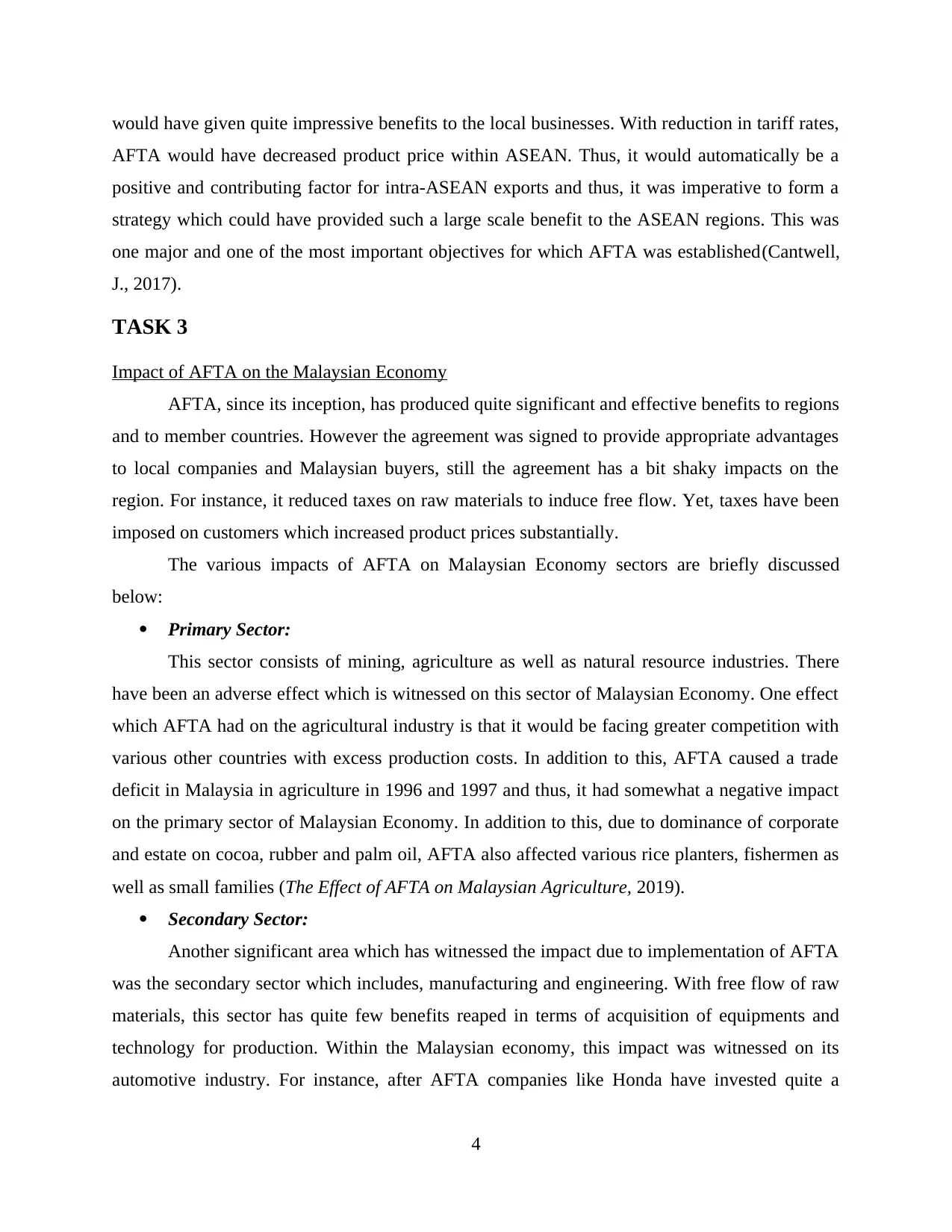
would have given quite impressive benefits to the local businesses. With reduction in tariff rates,
AFTA would have decreased product price within ASEAN. Thus, it would automatically be a
positive and contributing factor for intra-ASEAN exports and thus, it was imperative to form a
strategy which could have provided such a large scale benefit to the ASEAN regions. This was
one major and one of the most important objectives for which AFTA was established(Cantwell,
J., 2017).
TASK 3
Impact of AFTA on the Malaysian Economy
AFTA, since its inception, has produced quite significant and effective benefits to regions
and to member countries. However the agreement was signed to provide appropriate advantages
to local companies and Malaysian buyers, still the agreement has a bit shaky impacts on the
region. For instance, it reduced taxes on raw materials to induce free flow. Yet, taxes have been
imposed on customers which increased product prices substantially.
The various impacts of AFTA on Malaysian Economy sectors are briefly discussed
below:
Primary Sector:
This sector consists of mining, agriculture as well as natural resource industries. There
have been an adverse effect which is witnessed on this sector of Malaysian Economy. One effect
which AFTA had on the agricultural industry is that it would be facing greater competition with
various other countries with excess production costs. In addition to this, AFTA caused a trade
deficit in Malaysia in agriculture in 1996 and 1997 and thus, it had somewhat a negative impact
on the primary sector of Malaysian Economy. In addition to this, due to dominance of corporate
and estate on cocoa, rubber and palm oil, AFTA also affected various rice planters, fishermen as
well as small families (The Effect of AFTA on Malaysian Agriculture, 2019).
Secondary Sector:
Another significant area which has witnessed the impact due to implementation of AFTA
was the secondary sector which includes, manufacturing and engineering. With free flow of raw
materials, this sector has quite few benefits reaped in terms of acquisition of equipments and
technology for production. Within the Malaysian economy, this impact was witnessed on its
automotive industry. For instance, after AFTA companies like Honda have invested quite a
4
AFTA would have decreased product price within ASEAN. Thus, it would automatically be a
positive and contributing factor for intra-ASEAN exports and thus, it was imperative to form a
strategy which could have provided such a large scale benefit to the ASEAN regions. This was
one major and one of the most important objectives for which AFTA was established(Cantwell,
J., 2017).
TASK 3
Impact of AFTA on the Malaysian Economy
AFTA, since its inception, has produced quite significant and effective benefits to regions
and to member countries. However the agreement was signed to provide appropriate advantages
to local companies and Malaysian buyers, still the agreement has a bit shaky impacts on the
region. For instance, it reduced taxes on raw materials to induce free flow. Yet, taxes have been
imposed on customers which increased product prices substantially.
The various impacts of AFTA on Malaysian Economy sectors are briefly discussed
below:
Primary Sector:
This sector consists of mining, agriculture as well as natural resource industries. There
have been an adverse effect which is witnessed on this sector of Malaysian Economy. One effect
which AFTA had on the agricultural industry is that it would be facing greater competition with
various other countries with excess production costs. In addition to this, AFTA caused a trade
deficit in Malaysia in agriculture in 1996 and 1997 and thus, it had somewhat a negative impact
on the primary sector of Malaysian Economy. In addition to this, due to dominance of corporate
and estate on cocoa, rubber and palm oil, AFTA also affected various rice planters, fishermen as
well as small families (The Effect of AFTA on Malaysian Agriculture, 2019).
Secondary Sector:
Another significant area which has witnessed the impact due to implementation of AFTA
was the secondary sector which includes, manufacturing and engineering. With free flow of raw
materials, this sector has quite few benefits reaped in terms of acquisition of equipments and
technology for production. Within the Malaysian economy, this impact was witnessed on its
automotive industry. For instance, after AFTA companies like Honda have invested quite a
4
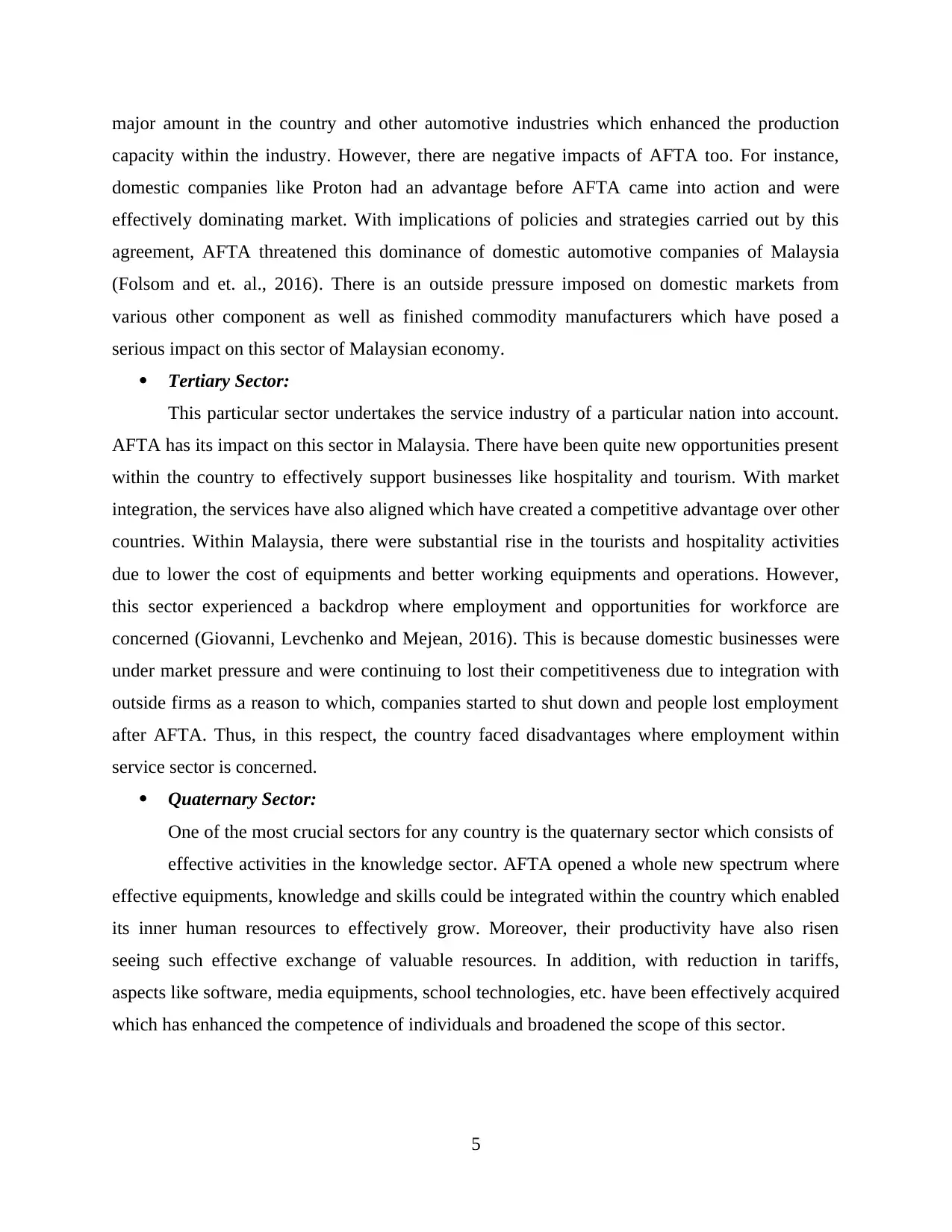
major amount in the country and other automotive industries which enhanced the production
capacity within the industry. However, there are negative impacts of AFTA too. For instance,
domestic companies like Proton had an advantage before AFTA came into action and were
effectively dominating market. With implications of policies and strategies carried out by this
agreement, AFTA threatened this dominance of domestic automotive companies of Malaysia
(Folsom and et. al., 2016). There is an outside pressure imposed on domestic markets from
various other component as well as finished commodity manufacturers which have posed a
serious impact on this sector of Malaysian economy.
Tertiary Sector:
This particular sector undertakes the service industry of a particular nation into account.
AFTA has its impact on this sector in Malaysia. There have been quite new opportunities present
within the country to effectively support businesses like hospitality and tourism. With market
integration, the services have also aligned which have created a competitive advantage over other
countries. Within Malaysia, there were substantial rise in the tourists and hospitality activities
due to lower the cost of equipments and better working equipments and operations. However,
this sector experienced a backdrop where employment and opportunities for workforce are
concerned (Giovanni, Levchenko and Mejean, 2016). This is because domestic businesses were
under market pressure and were continuing to lost their competitiveness due to integration with
outside firms as a reason to which, companies started to shut down and people lost employment
after AFTA. Thus, in this respect, the country faced disadvantages where employment within
service sector is concerned.
Quaternary Sector:
One of the most crucial sectors for any country is the quaternary sector which consists of
effective activities in the knowledge sector. AFTA opened a whole new spectrum where
effective equipments, knowledge and skills could be integrated within the country which enabled
its inner human resources to effectively grow. Moreover, their productivity have also risen
seeing such effective exchange of valuable resources. In addition, with reduction in tariffs,
aspects like software, media equipments, school technologies, etc. have been effectively acquired
which has enhanced the competence of individuals and broadened the scope of this sector.
5
capacity within the industry. However, there are negative impacts of AFTA too. For instance,
domestic companies like Proton had an advantage before AFTA came into action and were
effectively dominating market. With implications of policies and strategies carried out by this
agreement, AFTA threatened this dominance of domestic automotive companies of Malaysia
(Folsom and et. al., 2016). There is an outside pressure imposed on domestic markets from
various other component as well as finished commodity manufacturers which have posed a
serious impact on this sector of Malaysian economy.
Tertiary Sector:
This particular sector undertakes the service industry of a particular nation into account.
AFTA has its impact on this sector in Malaysia. There have been quite new opportunities present
within the country to effectively support businesses like hospitality and tourism. With market
integration, the services have also aligned which have created a competitive advantage over other
countries. Within Malaysia, there were substantial rise in the tourists and hospitality activities
due to lower the cost of equipments and better working equipments and operations. However,
this sector experienced a backdrop where employment and opportunities for workforce are
concerned (Giovanni, Levchenko and Mejean, 2016). This is because domestic businesses were
under market pressure and were continuing to lost their competitiveness due to integration with
outside firms as a reason to which, companies started to shut down and people lost employment
after AFTA. Thus, in this respect, the country faced disadvantages where employment within
service sector is concerned.
Quaternary Sector:
One of the most crucial sectors for any country is the quaternary sector which consists of
effective activities in the knowledge sector. AFTA opened a whole new spectrum where
effective equipments, knowledge and skills could be integrated within the country which enabled
its inner human resources to effectively grow. Moreover, their productivity have also risen
seeing such effective exchange of valuable resources. In addition, with reduction in tariffs,
aspects like software, media equipments, school technologies, etc. have been effectively acquired
which has enhanced the competence of individuals and broadened the scope of this sector.
5
Paraphrase This Document
Need a fresh take? Get an instant paraphrase of this document with our AI Paraphraser

TASK 4
Application of Comparative Advantage Theory of International Trade on AFTA
Comparative advantage theory is given by David Ricardo in 18th century which state that
a country will gain comparative advantage when it produce goods or services at relatively lower
cost as compare to another country. According to David Ricardo a country can boosts up its
economical growth by focusing over the industry which help it in providing sustainable
comparative advantage. This approach was developed in order to combat with trade restriction
practices that are usually faced by countries while importing of good or services. This theory
work over an aim of providing mutual benefit to parties involve in trade agreement from
voluntary and cooperation trade. It is also consider as foundational principle of international
trade.
This theory is perfectly fit over the ASEAN Free Trade Agreement (AFTA) as this is
formed to facilitate integration of economy among six countries and to make them enjoy the free
flow of trade which also support in enhancing their economical growth. This agreement is
usually formed to provide countries mutual benefit over their trade practices that support them in
economical growth. On the other side, comparative theory focuses over principle that a country
must product product or services in which it can earn more then another country and achieve
comparative advantage. So, by implementation of this theory at international trade ASEAN
countries can focuses over retaining products which have comparative advantage by enhancing
their production capacity. This help in diverting the focus of ASEAN country toward
specialization because as per comparative advantage theory a nation must try to exploit that in
order to become specialized in that product. For instance, Malaysia is more technological
advanced and it posses high comparative advantage in technologically advanced product but the
future of this industry is based over the capability or resource availability of country to deal with
future threats. On the other side China's bilateral AFTA trade agreement allow it to perform free
flow of good or service in several different countries over an international market. China is also
having specialisation in technology based products and because of which Malaysia is getting
huge competition from China as they both are specialised in same industrial product. So in order
to get comparative advantage in this Malaysia must focuses over exploit the technological based
product and try to improve its quality. This will help them in gaining m,ore competitive
6
Application of Comparative Advantage Theory of International Trade on AFTA
Comparative advantage theory is given by David Ricardo in 18th century which state that
a country will gain comparative advantage when it produce goods or services at relatively lower
cost as compare to another country. According to David Ricardo a country can boosts up its
economical growth by focusing over the industry which help it in providing sustainable
comparative advantage. This approach was developed in order to combat with trade restriction
practices that are usually faced by countries while importing of good or services. This theory
work over an aim of providing mutual benefit to parties involve in trade agreement from
voluntary and cooperation trade. It is also consider as foundational principle of international
trade.
This theory is perfectly fit over the ASEAN Free Trade Agreement (AFTA) as this is
formed to facilitate integration of economy among six countries and to make them enjoy the free
flow of trade which also support in enhancing their economical growth. This agreement is
usually formed to provide countries mutual benefit over their trade practices that support them in
economical growth. On the other side, comparative theory focuses over principle that a country
must product product or services in which it can earn more then another country and achieve
comparative advantage. So, by implementation of this theory at international trade ASEAN
countries can focuses over retaining products which have comparative advantage by enhancing
their production capacity. This help in diverting the focus of ASEAN country toward
specialization because as per comparative advantage theory a nation must try to exploit that in
order to become specialized in that product. For instance, Malaysia is more technological
advanced and it posses high comparative advantage in technologically advanced product but the
future of this industry is based over the capability or resource availability of country to deal with
future threats. On the other side China's bilateral AFTA trade agreement allow it to perform free
flow of good or service in several different countries over an international market. China is also
having specialisation in technology based products and because of which Malaysia is getting
huge competition from China as they both are specialised in same industrial product. So in order
to get comparative advantage in this Malaysia must focuses over exploit the technological based
product and try to improve its quality. This will help them in gaining m,ore competitive
6

advantage that contribute toward the achievement of comparative advantage by earning more
over their trading of product as compare to China.
Apart from this Malaysia is also having comparative advantage within resource based
industry which offer product that are made up of wood. Malaysia also get benefit in trading
resource based industrial product with the entry of China into WTO in economical terms. The
reason behind this is that Malaysia can produce furniture at relatively lower cost as compare to
another country because of availability of natural resources. There are three main factors that
support Malaysia in getting comparative advantage within this industry it includes labour
productivity, unit labour cost and salary & wages per worker. This comparative advantage will
help Malaysia in gaining more economical benefit at international trade with the help of AFTA
free flow trade agreement in which it is involved.
Summary
ASEAN Free Trade Agreement has been an effective integration of various economies
which facilitated free flow of resources and market integration.
There have been important and quite effective aspects regarding AFTA which has been
effectively reviewed in the report.
The first aspect effectively covered the concept of Regional Economic Integration, within
which, five levels of integration has been showcased as well as analysed. All these levels are
distinctive in nature and cover different types of integration which could happen between
countries.
Another aspect which has been discussed in this report is the objectives for the
formulation of AFTA. Four objectives as per the policy makers and ASEAN heads are examined
which provided effective insight onto the reasons which were the main factors of formation of
this agreement (Perri and Peruffo, 2016).
This report then defines impact of AFTA on Malaysian Economy. All the sectors within
the economy are evaluated on the basis of impact bore by them and thus, it was determined that
while AFTA had majority of positive impacts on the country, various sectors like agriculture and
employment were subjected to negative impact as well.
Comparative advantage theory was also applied on international trade on AFTA. Various
instances and intra-AFTA trades have been highlighted and comparative advantage is shown
through appropriate application.
7
over their trading of product as compare to China.
Apart from this Malaysia is also having comparative advantage within resource based
industry which offer product that are made up of wood. Malaysia also get benefit in trading
resource based industrial product with the entry of China into WTO in economical terms. The
reason behind this is that Malaysia can produce furniture at relatively lower cost as compare to
another country because of availability of natural resources. There are three main factors that
support Malaysia in getting comparative advantage within this industry it includes labour
productivity, unit labour cost and salary & wages per worker. This comparative advantage will
help Malaysia in gaining more economical benefit at international trade with the help of AFTA
free flow trade agreement in which it is involved.
Summary
ASEAN Free Trade Agreement has been an effective integration of various economies
which facilitated free flow of resources and market integration.
There have been important and quite effective aspects regarding AFTA which has been
effectively reviewed in the report.
The first aspect effectively covered the concept of Regional Economic Integration, within
which, five levels of integration has been showcased as well as analysed. All these levels are
distinctive in nature and cover different types of integration which could happen between
countries.
Another aspect which has been discussed in this report is the objectives for the
formulation of AFTA. Four objectives as per the policy makers and ASEAN heads are examined
which provided effective insight onto the reasons which were the main factors of formation of
this agreement (Perri and Peruffo, 2016).
This report then defines impact of AFTA on Malaysian Economy. All the sectors within
the economy are evaluated on the basis of impact bore by them and thus, it was determined that
while AFTA had majority of positive impacts on the country, various sectors like agriculture and
employment were subjected to negative impact as well.
Comparative advantage theory was also applied on international trade on AFTA. Various
instances and intra-AFTA trades have been highlighted and comparative advantage is shown
through appropriate application.
7
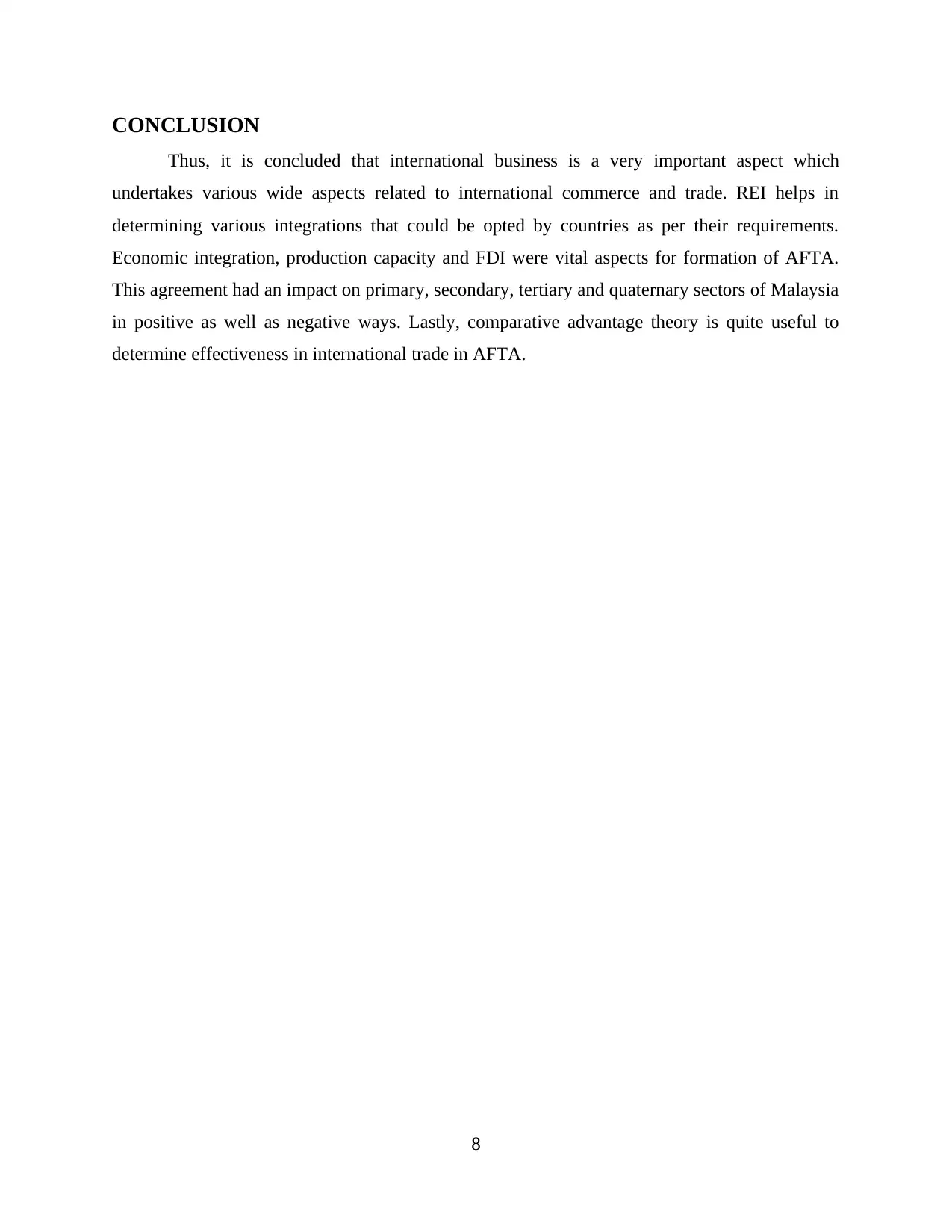
CONCLUSION
Thus, it is concluded that international business is a very important aspect which
undertakes various wide aspects related to international commerce and trade. REI helps in
determining various integrations that could be opted by countries as per their requirements.
Economic integration, production capacity and FDI were vital aspects for formation of AFTA.
This agreement had an impact on primary, secondary, tertiary and quaternary sectors of Malaysia
in positive as well as negative ways. Lastly, comparative advantage theory is quite useful to
determine effectiveness in international trade in AFTA.
8
Thus, it is concluded that international business is a very important aspect which
undertakes various wide aspects related to international commerce and trade. REI helps in
determining various integrations that could be opted by countries as per their requirements.
Economic integration, production capacity and FDI were vital aspects for formation of AFTA.
This agreement had an impact on primary, secondary, tertiary and quaternary sectors of Malaysia
in positive as well as negative ways. Lastly, comparative advantage theory is quite useful to
determine effectiveness in international trade in AFTA.
8
Secure Best Marks with AI Grader
Need help grading? Try our AI Grader for instant feedback on your assignments.
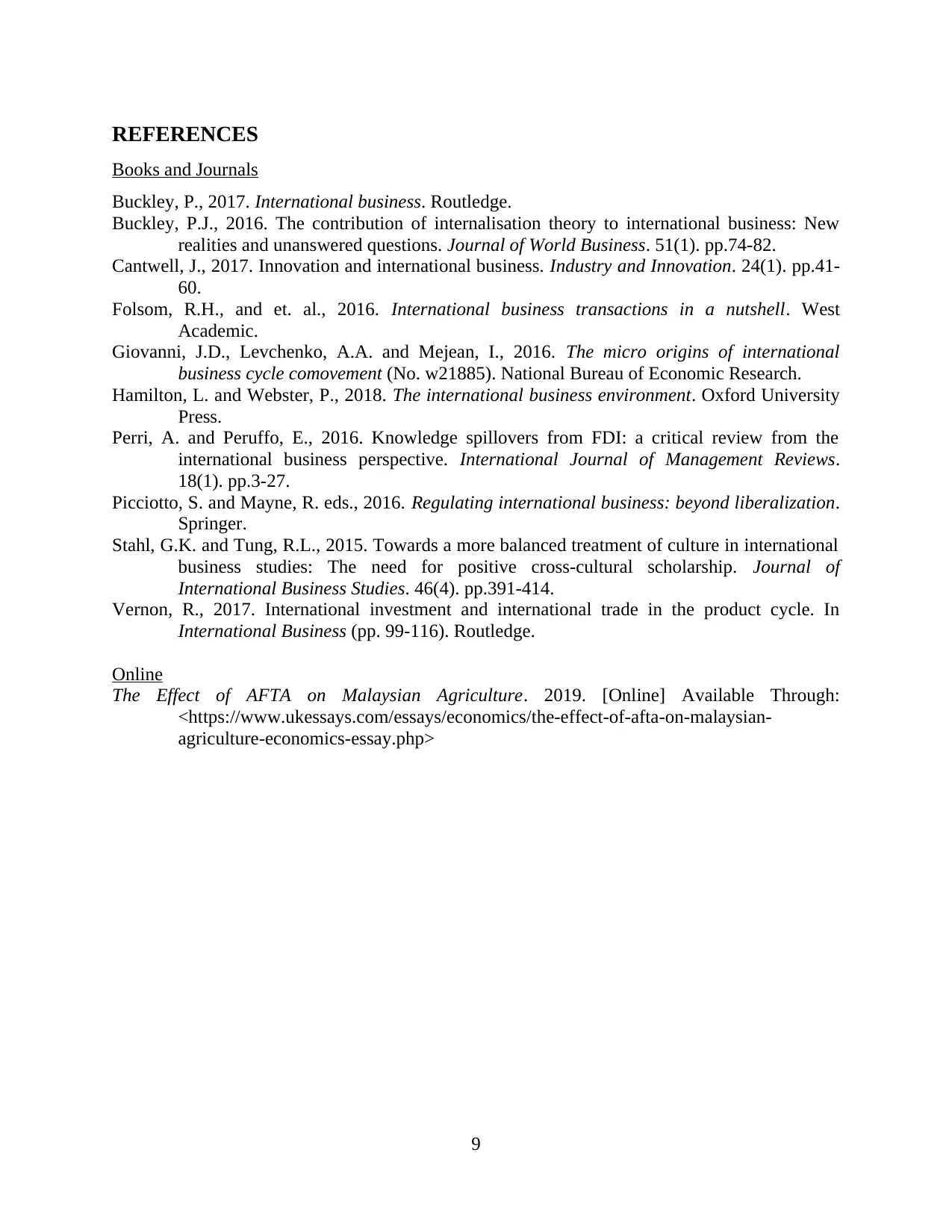
REFERENCES
Books and Journals
Buckley, P., 2017. International business. Routledge.
Buckley, P.J., 2016. The contribution of internalisation theory to international business: New
realities and unanswered questions. Journal of World Business. 51(1). pp.74-82.
Cantwell, J., 2017. Innovation and international business. Industry and Innovation. 24(1). pp.41-
60.
Folsom, R.H., and et. al., 2016. International business transactions in a nutshell. West
Academic.
Giovanni, J.D., Levchenko, A.A. and Mejean, I., 2016. The micro origins of international
business cycle comovement (No. w21885). National Bureau of Economic Research.
Hamilton, L. and Webster, P., 2018. The international business environment. Oxford University
Press.
Perri, A. and Peruffo, E., 2016. Knowledge spillovers from FDI: a critical review from the
international business perspective. International Journal of Management Reviews.
18(1). pp.3-27.
Picciotto, S. and Mayne, R. eds., 2016. Regulating international business: beyond liberalization.
Springer.
Stahl, G.K. and Tung, R.L., 2015. Towards a more balanced treatment of culture in international
business studies: The need for positive cross-cultural scholarship. Journal of
International Business Studies. 46(4). pp.391-414.
Vernon, R., 2017. International investment and international trade in the product cycle. In
International Business (pp. 99-116). Routledge.
Online
The Effect of AFTA on Malaysian Agriculture. 2019. [Online] Available Through:
<https://www.ukessays.com/essays/economics/the-effect-of-afta-on-malaysian-
agriculture-economics-essay.php>
9
Books and Journals
Buckley, P., 2017. International business. Routledge.
Buckley, P.J., 2016. The contribution of internalisation theory to international business: New
realities and unanswered questions. Journal of World Business. 51(1). pp.74-82.
Cantwell, J., 2017. Innovation and international business. Industry and Innovation. 24(1). pp.41-
60.
Folsom, R.H., and et. al., 2016. International business transactions in a nutshell. West
Academic.
Giovanni, J.D., Levchenko, A.A. and Mejean, I., 2016. The micro origins of international
business cycle comovement (No. w21885). National Bureau of Economic Research.
Hamilton, L. and Webster, P., 2018. The international business environment. Oxford University
Press.
Perri, A. and Peruffo, E., 2016. Knowledge spillovers from FDI: a critical review from the
international business perspective. International Journal of Management Reviews.
18(1). pp.3-27.
Picciotto, S. and Mayne, R. eds., 2016. Regulating international business: beyond liberalization.
Springer.
Stahl, G.K. and Tung, R.L., 2015. Towards a more balanced treatment of culture in international
business studies: The need for positive cross-cultural scholarship. Journal of
International Business Studies. 46(4). pp.391-414.
Vernon, R., 2017. International investment and international trade in the product cycle. In
International Business (pp. 99-116). Routledge.
Online
The Effect of AFTA on Malaysian Agriculture. 2019. [Online] Available Through:
<https://www.ukessays.com/essays/economics/the-effect-of-afta-on-malaysian-
agriculture-economics-essay.php>
9
1 out of 11
Related Documents
Your All-in-One AI-Powered Toolkit for Academic Success.
+13062052269
info@desklib.com
Available 24*7 on WhatsApp / Email
![[object Object]](/_next/static/media/star-bottom.7253800d.svg)
Unlock your academic potential
© 2024 | Zucol Services PVT LTD | All rights reserved.





